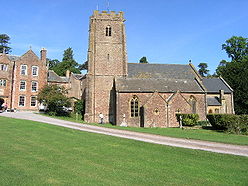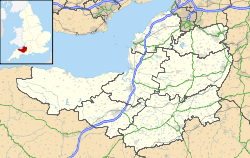- Nettlecombe Court
-
Nettlecombe Court 
Nettlecombe Court Field CentreGeneral information Town or city Williton Country England Coordinates 51°07′44″N 3°21′06″W / 51.1289°N 3.3518°W Nettlecombe Court is a large country mansion in the English county of Somerset. Nettlecombe Court was originally built as a manor house, becoming a girls' boarding school in the early 1960s and since 1967 has been the Leonard Wills Field Centre run by the Field Studies Council. The house is surrounded by Nettlecombe Park, a 90.4 hectares (223 acres) Site of Special Scientific Interest (SSSI).
The house and park are set in a secluded valley on the northern fringes of the Brendon Hills, within the Exmoor National Park. They are within the civil parish of Nettlecombe, named after the house, and are approximately 3.6 miles (5.8 km) from the village of Williton.
Contents
The house
Nettlecombe Court has a late medieval hall, with the entrance front, porch, great hall and parlour added in 1599. Around 1641 there were further additions to rear of great hall, and between 1703 and 1707 the South West front was extended. It has been designated by English Heritage as a grade I listed building.[1]
As stated in Nettlecombe Court, by R. J. E. Bush,"Nettlecombe is first mentioned in the Domesday book of 1086, when it was stated to be held by William the Conquerer, and in the charge of his Sheriff for Somerset, William de Mohun." A family lineage published in Nettlecombe Court shows that the estate passed into the Trevelyan family in 1452, upon the marriage of Elizabeth Whalesburgh to John Trevelyan. It remained as a family estate in the Trevelyan family until the mid nineteen hundreds.
Nearby hills and woodlands, including Exmoor National Park, provide excellent opportunities for general introductory courses on environmental themes. Habitats include marine, freshwater and heather moorland and the surrounding settlements range from hamlets to villages to the country town of Taunton.
The park
Nettlecombe Park Site of Special Scientific Interest Area of Search Somerset Grid reference ST055375 Interest Biological Area 90.4 hectare (223.4 acre) Notification 1990 Location map English Nature Nettlecombe Park is important for its lichen flora. Records suggest this site has been wood pasture or parkland for at least 400 years. There are some very old oak pollards which may be of this age or older. The oldest standard trees are over 200 years of age. The continuity of open woodland and parkland, with large mature and over-mature timber, has enabled characteristic species of epiphytic lichens and beetles to become established and persist. Many of these species are now nationally scarce because this type of habitat has been eliminated over large areas of Great Britain.[2]
The park was notified as an SSSI in 1990.
Within the grounds is the Church of St Mary the Virgin which is also a Grade I listed building.[3]
See also
- List of Grade I listed buildings in West Somerset
References
- ^ "Leonard Wills Field Centre(formerly listed as NettlecombeCourt)" (http). English Heritage. http://www.imagesofengland.org.uk/details/default.aspx?id=264791. Retrieved 2007-11-16.
- ^ "Nettlecombe Park". English Nature. http://www.english-nature.org.uk/citation/citation_photo/1005670.pdf. Retrieved 2006-08-17.
- ^ "Church of St Mary the Virgin". Images of England. English Heritage. http://www.imagesofengland.org.uk/Details/Default.aspx?id=264787. Retrieved 2008-10-07.
Bibliography
- Rose, Francis; P. Wolseley (1984). Nettlecombe Park: Its History and Its Epiphytic Lichens - An Attempt at Correlation. Field Studies Council. ISBN 1-85153-165-3.
External links
Categories:- Visitor attractions in Somerset
- Country houses in Somerset
- Sites of Special Scientific Interest in Somerset
- Sites of Special Scientific Interest notified in 1990
- Grade I listed buildings in Somerset
- Exmoor
Wikimedia Foundation. 2010.

